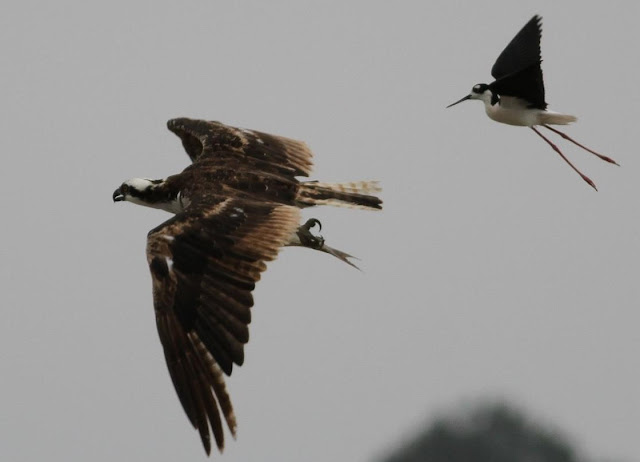The last few days have been drizzly and overcast for most
of the day but today appeared promising as the ski grew brighter. I decided to
head for Rios Avenue in Solana Beach and check out the Pole Road Trail at San Elijo Lagoon today.
As I approached the viewpoint for the Peninsula Trail, I
ran into a birder that informed me there were lots of baby Clappers running
around in the mud paddies by the pump house. He offered to take me to the area
where he observed several youngsters and adults darting out on the exposed mud.
Here is a long distance shot of a young California Clapper Rail looking for lunch.
They are really quick to move from perceived or real
danger and appear to like to run or swim more than fly.
As I pass the pump house, a Black-necked Stilt flies
in.
These birds are so very elegant and always a great subject to
shoot.
Just past the area where I spotted the Stilt, an Osprey is
perched on top of a short utility pole with prey. Looks like he has finished off
half of what looks to be the remains of a mullet.
Ospreys are always exciting to photograph. They have such
wonderful expressions and are usually somewhat tolerant of photographers if we stay
back far enough from their space.
Always on the lookout for trouble that may approach.
Looks in all direction.
Eye to eye.
Love the swept up plumage when the wind catches it.
A beautiful angle of the Osprey's head.
Looking at a few hikers walking by...
Back into the camera.
The Osprey decides there are too many humans around for
his comfort... up with his wings and getting a good grip on his fish.
Off he goes.
Nice look at his talons locked on the fish.
He flies south but changes his mind and loops back towards me.
Now he is heading northeast.
Flying right over what I call the "salt flats".
Nice look at how the Osprey carries his prey.
He spots something and seems to be very alert.
Trying to get some height.
Now I see the reason for his concern. A Black-neck Stilt
is on the chase, he is enforcing his "no fly zone" area. The Stilt may have a
youngster he is protecting but this was quite an unusual sight to see.
I have never seen a Black-neck Stilt be so aggressive with an Osprey before.
For every beat of the Osprey's wings the Black-necked Stilt
is right behind him like a shadow.
The Osprey appears uncomfortable with this bird coming so
close into his airspace.
The Osprey picks up speed and powers out of the offending
area.
The Stilt appears to be escorting this much larger raptor
out of his air space.
One last rush towards the Osprey and he peels back and
flies back to the salt flats.
Coming in for a landing. Such a graceful bird.
Even when walking, they are a show of elegance.
A close look at the head and neck.
I head for home and spot another pair of Black-necked Stilts
foraging in the tide channel by the railroad tracks north of the pump house.
A nice stretch and display of his wings.
Gives me a close look at his beautiful head.
The Stilt pauses for a moment as I walk by.
A shot of the Black-necked Stilt a split second before he takes flight. He uses his legs like a slingshot to give him a easy lift off.








































































